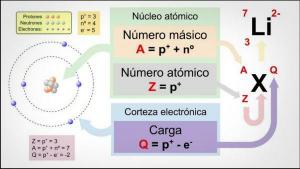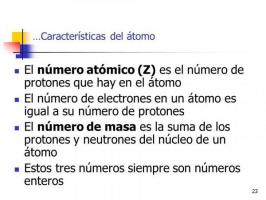Characteristics of the THOMSON atomic MODEL

Throughout history, different scientists have proposed models that tried to explain what the structure of atoms. One of these scientists was J.J. Thomson. In this lesson from a TEACHER we offer you a summary of the features of the Thomson's atomic model most prominent.
Joseph John Thomson was a mathematician and physicist that at the end of the s. XIX and principles of the XX he worked in several experiments that allowed him to establish an atomic model that explained the knowledge of the atom that they had then.
He experimented with electric discharges in gases at low pressures, which led to the discovery of the electron in 1897, one of the most important events in science.
His experiments were made possible by the invention of the CRT from William Crookes a few years earlier (1975). The Crookes experiments they had established a series of characteristics of cathode rays that ultimately led to Thomson's discovery of the electron. The discovery of the electron allowed Thomson to propose an atomic model that took into account the characteristics of this newly discovered subatomic particle.
Under normal conditions, a gas is a poor conductor of electricity. However, under the conditions that are established in the cathode rays, where the gas is at very low pressures and where a potential difference is established by introducing two electrodes into the tube; the gases become conductors of electricity.
One of the key discoveries made by Thomson with his cathode ray experiments it was the deflection of cathode rays subjected to an electric field. At that time there were various theories about the nature of cathode rays. While German physicists regarded cathode rays as some kind of radiation, British physicists considered that these rays were formed by some type of negatively charged particle, as it was deduced from previous experiments by Crookes.
The improvement in obtaining low pressures inside cathode ray tubes allowed Thomson to accurately observe the effect of electric fields on cathode rays. Cathode rays were known to travel in straight lines in the absence of electric or magnetic fields.
Thomson introduced two metal platess, parallel to the path of the cathode rays, in the cathode ray tube and established between them a potential difference, a scale in the part end of the tube where the cathode rays impinged allowed to measure the degree of deviation of the rays when they were subjected to different differences of potential. Previously, the deflection of cathode rays by the effect of magnetic fields had already been observed.
Thomson conducted experiments in which he counteracts the deflection of cathode rays by simultaneously applying electric and magnetic fields. These experiments will allowed to determine the speed of cathode rays and the mass and charge of the particles that formed them.
Two key discoveries allowed Thomson the discovery of the electron, which he initially called corpuscle:
- The charge / mass ratio of the corpuscle was 1000 times higher than any particle previously described. The smallest known at that time was the hydrogen atom. This means that it is negatively charged particles with practically zero mass.
- The charge / mass ratio did not vary when different gases or different metals were used in the electrodes. Thus, he deduced that the nature of the particle was independent of the type of gas or metal used in the electrodes. In other words, the discovered particle was a universal component of matter.

After the discovery of the electron, Thomson proposed an atomic model in 1904 in which the knowledge that was had at that time was considered: It was aware of the existence of particles with positive and negative charges in the atom. He himself had discovered the electron a few years ago and previously, the German physicist Eugene Goldenstein, who discovered the channel rays, anodic or positive. These rays traveled in the opposite direction to the cathode rays inside the tubes. The opposite direction of these rays deduced that their charge was positive.
Taking all this into account, Thomson proposed a model with the following characteristics:
- The atom would be composed of a sphere that would concentrate all the mass of the atom and have a positive charge.
- The electrons would be embedded in this sphere, distributed in space and compensating for the positive charge of said sphere.
- East model was not staticRather, Thomson believed that electrons could change their position within the positive sphere, as long as the charges will be compensated.
The model proposed by Thomson is popularly known as raisin pudding pattern: the mass of the pudding would be the positive sphere that concentrates the mass and, the electrons distributed inside it would be the raisins of the cake.
Thomson's atomic model explained the formation of ions through the loss or gain of these negative corpuscles or electrons that were embedded in the sphere of positive charge. In addition, Thomson built the atomic models of the first six elements of the periodic table.

Thomson's atomic model presented several problems, since it could not explain some of the observations made until then.
The main problems were the following:
- Thomson's atomic model was based on the idea of an atomic particle that homogeneously distributed the positive charge, but its existence had not been proven.
- Nor could he explain all the periodic properties of the elements, which had been described until then.
- Above all, Thomson's atomic model, he couldn't explain the results obtained by Rutherford, in an experiment in which he bombarded a fine gold foil with alpha particles (Helium cations). According to the Thomson model, the alpha particles should have passed through the sheet without deviating. Instead, what Rutherford observed was that one in every 10,000 particles suffered some deviation in its trajectory.
In a few years, this model was discarded in favor of Rutherford's atomic model, according to which, the electrons revolved in orbits around a nucleus that concentrated all the positive charge of the atom.
If you want to read more articles similar to Thomson's atomic model: characteristics and summary, we recommend that you enter our category of The atom.



